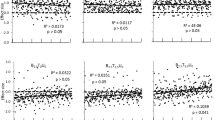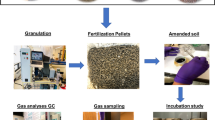Abstract
The pH of manure pellet fertilizer can affect the nitrous oxide (N2O) emission from soil, although its effectiveness and the relative mechanisms are not well understood. This study aims to quantify the effect of cattle-manure-based pellet pH on N2O emissions from an Andosol field. The field experiment consisted of four treatments: chemical (mineral) fertilizer (CF), cattle-manure-based pellet fertilizer of pH 5.6 (OP), cattle-manure-based pellet fertilizer of pH 7.1 (NP), and cattle-manure-based pellet fertilizer of pH 10.1 (AP). Cumulative N2O emission over the 365 days in the OP and NP treatments was 59.4% and 49.3% lower than that in the AP treatment, respectively, but the cumulative N2O emissions were statistically significant only between the OP and AP treatments. Moreover, cumulative N2O emission in the pellet fertilizer treatments during the peak period after fertilization in the autumn and spring crop** seasons (total 70 days) increased with increasing pellet pH. In the pellet fertilizer treatments, soil nitrification potential, soil N2O production rate, and total denitrification rate of soil also clearly increased with the increase of pellet pH. Therefore, slightly acidic pellet pH (OP treatment) may have inhibited the microbial N2O production processes in comparison to the neutral pellet pH (NP treatment), but alkaline pellet pH (AP treatment) could have stimulated the microbial N2O production processes than the neutral pellet pH. These results suggested that increased N2O emission with an increase in pellet pH may be attributed to a change in the N2O production rate via nitrification and denitrification.





Similar content being viewed by others
Data availability
Data will be made available on request.
References
Azam F, Müller C, Weiske A, Benckiser G (2002) Nitrification and denitrification as sources of atmospheric nitrous oxide—role of oxidizable carbon and applied nitrogen. Biol Fertil Soils 35:54–61
Baggs EM, Philippot L (2010) Microbial terrestrial pathways to nitrous oxide. In: Smith K (ed) Nitrous oxide and climate change. Earthscan, London, pp 4–35
Bateman EJ, Baggs EM (2005) Contribution of nitrification and denitrification to N2O emissions from soils at different water-filled pore space. Biol Fertil Soils 41:379–388
Beare MH, Gregorich EG, St-Georges P (2009) Compaction effects on CO2 and N2O production during drying and rewetting of soil. Soil Biol Biochem 41:611–621
Belser LW, Mays EL (1980) Specific inhibition of nitrite oxidation by chlorate and its use in assessing nitrification in soils and sediments. Appl Environ Microbiol 39:505–510
Blum JM, Su Q, Ma Y, Valverde-Pérez B, Domingo-Félez C, Jensen MM, Smets BF (2018) The pH dependency of N-converting enzymatic processes, pathways and microbes: effect on net N2O production. Environ Microbiol 20:1623–1640
Butterbach-Bahl K, Baggs EM, Dannenmann M, Kiese R, Zechmeister-Boltenstern S (2013) Nitrous oxide emissions from soils: how well do we understand the processes and their controls? Philos Trans R Soc B Biol Sci 368:20130122. https://doi.org/10.1098/rstb.2013.0122
Cabrera ML, Chiang SC, Merka WC, Pancorbo OC, Thompson SA (1994a) Pelletizing and soil water effects on gaseous emissions from surface applied poultry litter. Soil Sci Soc Am J 58:807–811
Cabrera ML, Chiang SC, Merka WC, Pancorbo OC, Thompson SA (1994b) Nitrous oxide and carbon dioxide emissions from pelletized and nonpelletized poultry litter incorporated into soil. Plant Soil 163:189–196
Chakraborty A, Chakrabarti K, Chakraborty A, Ghosh S (2011) Effect of long-term fertilizers and manure application on microbial biomass and microbial activity of a tropical agricultural soil. Biol Fertil Soils 47:227–233
Chen H, Li X, Hu F, Shi W (2013) Soil nitrous oxide emissions following crop residue addition: a meta-analysis. Glob Chang Biol 19:2956–2964
Chiyoka WL, Hao X, Zvomuya F, Li X (2011) Nitrous oxide emissions from Chernozemic soils amended with anaerobically digested beef cattle feedlot manure: a laboratory study. Anim Feed Sci Technol 166–167:492–502
Chu H, Hujii T, Morimoto S, Lin X, Yagi K (2008) Population size and specific nitrification potential of soil ammonia-oxidizing bacteria under long-term fertilizer management. Soil Biol Biochem 40:1960–1963
Ciarlo E, Conti M, Bartoloni N, Rubio G (2007) The effect of moisture on nitrous oxide emissions from soil and the N2O/(N2O+N2) ratio under laboratory conditions. Biol Fertil Soils 43:675–681
Conen F, Dobbie KE, Smith KA (2000) Predicting N2O emissions from agricultural land through related soil parameters. Glob Chang Biol 6:417–426
Dobbie KE, Smith KA (2003) Nitrous oxide emission factors for agricultural soils in Great Britain: the impact of soil water-filled pore space and other controlling variables. Glob Chang Biol 9:204–218
Granli T, Bøckman OC (1994) Nitrous oxide from agriculture. Norwegian J Agric Sci 12:7–127
Hara M, Ishikawa H, Furuichi Y (2003) Manufacturing conditions and handling improvement effects of pelletized compost from swine manure using a uniaxial extruder. Jpn J Soil Sci Plant Nutr 74:1–7 (in Japanese with English abstract)
Hayakawa A, Akiyama H, Sudo S, Yagi K (2009) N2O and NO emissions from an andisol field as influenced by pelleted poultry manure. Soil Biol Biochem 41:521–529
Hénault C, Grossel A, Mary B, Roussel M, Léonard J (2012) Nitrous oxide emission by agricultural soils: a review of spatial and temporal variability for mitigation. Pedosphere 22:426–433
Jones SK, Rees RM, Skiba UM, Ball BC (2007) Influence of organic and mineral N fertilizer on N2O fluxes from a temperate grassland. Agric Ecosyst Environ 121:74–83
Laanbroek HJ, Gerards S (1991) Effects of organic manure on nitrification in arable soils. Biol Fertil Soils 12:147–153
Li X, Han S, Wan W, Zheng L, Chen W, Huang Q (2020) Manure fertilizes alter the nitrite oxidizer and comammox community composition and increase nitrification rates. Soil Tillage Res 204:104701
Liu X, Herbert SJ, Hashemi AM, Zhang X, Ding G (2006) Effects of agricultural management on soil organic matter and carbon transformation—a review. Plant Soil Environ 52:531–543
MAFF (Ministry of Agriculture, Forestry and Fisheries) (2020) Statistical survey on livestock. https://www.maff.go.jp/j/tokei/kouhyou/tikusan/. Accessed 31 May 2021
Masson-Delmotte V, Zhai P, Pirani A, Connors SL, Péan C, Berger S, Caud N, Chen Y, Goldfarb L, Gomis MI, Huang M, Leitzell K, Lonnoy E, Matthews JBR, Maycock TK, Waterfield T, Yelekçi O, Yu R, Zhou B (2021) Climate change 2021: the physical science basis: contribution of Working Group I to the Sixth Assessment Report of the Intergovernmental Panel on Climate Change. Cambridge University Press, Cambridge
Mathieu O, Lévêque J, Hénault C, Milloux MJ, Bizouard F, Andreux F (2006) Emissions and spatial variability of N2O, N2, and nitrous oxide mole fraction at the field scale, revealed with 15N isotopic techniques. Soil Biol Biochem 38:941–951
Meyer RL, Kjær T, Revsbech NP (2002) Nitrification and denitrification near a soil-manure interface studied with a nitrate-nitrite biosensor. Soil Sci Soc Am J 66:498–506
Mu Z, Huang A, Kimura SD, ** T, Wei S, Hatano R (2009) Linking N2O emission to soil mineral N as estimated by CO2 emission and soil C/N ratio. Soil Biol Biochem 41:2593–2597
NIES (National Institute for Environmental Studies) (2022) National greenhouse gas inventory report of Japan. Ministry of the Environment, Japan
Pampuro N, Busato P, Cavallo E (2018) Gaseous emissions after soil application of pellet made from composted pig slurry solid fraction: effect of application method and pellet diameter. Agriculture 8:119. https://doi.org/10.3390/agriculture8080119
Parkin TB (1987) Soil microsites as a source of denitrification variability. Soil Sci Soc Am J 51:1194–1199
Petersen SO, Nielsen AL, Haarder K, Henriksen K (1992) Factors controlling nitrification and denitrification: a laboratory study with gel-stabilized liquid cattle manure. Microb Ecol 23:239–255
Petrova IP, Ruser R, Guzman-Bustamante I (2020) Pellets from biogas digestates: a substantial source of N2O emissions. Waste Biomass Valorization. https://doi.org/10.1007/s12649-020-01190-3
Ravishankara AR, Daniel JS, Portmann RW (2009) Nitrous oxide (N2O): the dominant ozone-depleting substance emitted in the 21st century. Science 326:123–125
Ruser R, Flessa H, Russow R, Schmidt G, Buegger F, Munch JC (2006) Emission of N2O, N2 and CO2 from soil fertilized with nitrate: effect of compaction, soil moisture and rewetting. Soil Biol Biochem 38:263–274
Saha D, Kaye JP, Bhowmik A, Bruns MA, Wallace JM, Kemanian AR (2021) Organic fertility inputs synergistically increase denitrification-derived nitrous oxide emissions in agroecosystems. Ecol Appl 31:e02403
Sahrawat KL (2008) Factors affecting nitrification in soils. Commun Soil Sci Plant Anal 39:1436–1446
Shammas NK (1986) Interactions of temperature, pH and biomass on the nitrification process. J Water Pollut Control Fed 58:52–58
Smith KA, McTaggart IP, Dobbie KE, Conen F (1998a) Emissions of N2O from Scottish agricultural soils, as a function of fertilizer N. Nutr Cycl Agroecosystems 52:123–130
Smith KA, Thomson PE, Clayton H, Mctaggart IP, Conen F (1998b) Effects of temperature, water content and nitrogen fertilization on emissions of nitrous oxide by soils. Atmosp Environ 32:3301–3309
Ste-Marie C, Pare D (1999) Soil, pH and N availability effects on net nitrification in the forest floors of a range of boreal forest stands. Soil Biol Biochem 31:1579–1589
Sun P, Zhuge Y, Zhang J, Cai Z (2012) Soil pH was the main controlling factor of the denitrification rates and N2/N2O emission ratios in forest and grassland soils along the northeast China transect (NECT). Soil Sci Plant Nutr 58:517–525
Tiedje JM, Sexstone AJ, Parkin TB, Revsbech NP, Shelton DR (1984) Anaerobic processes in soil. Plant Soil 76:197–212
Uchida Y, Wang Y, Akiyama H, Nakajima Y, Hayatsu M (2014) Expression of denitrification genes in response to a waterlogging event in a fluvisol and its relationship with large nitrous oxide pulses. FEMS Microbiol Ecol 88:407–423
van den Heuvel RN, Hefting MM, Tan NCG, Jetten MSM, Verhoeven JTA (2009) N2O emission hotspots at different spatial scales and governing factors for small scale hotspots. Sci Total Environ 407:2325–2332
Wang C, Lu H, Dong D, Deng H, Strong PJ, Wang H, Wu W (2013) Insight into the effects of biochar on manure composting: evidence supporting the relationship between N2O emission and denitrifying community. Environ Sci Technol 47:7341–7349
Weil RR, Brady NC (2017) The nature and properties of soils. Pearson Education, London, pp 392–437 (chapter 9), pp 763–835 (chapter 16)
Yamamoto A, Akiyama H, Naokawa T, Miyazaki Y, Honda Y, Sano Y, Nakajima Y, Yagi K (2014) Lime-nitrogen application affects nitrification, denitrification, and N2O emission in an acidic tea soil. Biol Fertil Soils 50:53–62
Yamane T (2013) Denitrifying bacterial community in manure compost pellets applied to an andosol upland field. Soil Sci Plant Nutr 59:572–579
Yamane T, Kubotera H (2016) Impacts of pellet pH on nitrous oxide emission rates from cattle manure compost pellets. Soil Sci Plant Nutr 62:561–566
Yanai J, Sawamoto T, Oe T, Kusa K, Yamakawa K, Sakamoto K, Naganawa T, Inubushi K, Hatano R, Kosaki T (2003) Spatial variability of nitrous oxide emissions and their soil-related determing factors in an agricultural field. J Environ Qual 32:1965–1977
Yoshinari T, Knowles R (1976) Acetylene inhibition of nitrous oxide reduction by denitrifying bacteria. Biochem Biophys Res Commun 69:705–710
Zhu K, Bruun S, Larsen M, Glud RN, Jensen LS (2014) Spatial oxygen distribution and nitrous oxide emissions from soil after manure application: a novel approach using planar optodes. J Environ Qual 43:1809–1812
Acknowledgements
We are grateful to Mr. Tomotaka Asano, Mr. Hideki Matsuoka, and Dr. Takashi Kenjou (Asahi Agria Co., Ltd., Japan) for manufacturing the pellet fertilizers and to Ms. Kiyomi Kamiyama (Kanagawa Agricultural Technology Center) and the staff of Kanagawa Agricultural Technology Center with the fieldwork. This work was supported by JSPS KAKENHI (Grant Nos. 19H03097 and 22H02475).
Author information
Authors and Affiliations
Contributions
AY: Conceptualization, Methodology, Investigation, Writing—original draft, Funding acquisition. KA: Investigation, Methodology. SS: Investigation, Methodology, Funding acquisition. Minoru Takemoto: Investigation. HN: Methodology.
Corresponding author
Ethics declarations
Competing interests
The authors declare no competing interests.
Additional information
Publisher's Note
Springer Nature remains neutral with regard to jurisdictional claims in published maps and institutional affiliations.
Supplementary Information
Below is the link to the electronic supplementary material.
Rights and permissions
Springer Nature or its licensor (e.g. a society or other partner) holds exclusive rights to this article under a publishing agreement with the author(s) or other rightsholder(s); author self-archiving of the accepted manuscript version of this article is solely governed by the terms of such publishing agreement and applicable law.
About this article
Cite this article
Yamamoto, A., Arai, K., Sudo, S. et al. Nitrous oxide emissions after application of cattle-manure-based pellet of different pH levels to an Andosol upland field. Nutr Cycl Agroecosyst 126, 35–49 (2023). https://doi.org/10.1007/s10705-023-10271-3
Received:
Accepted:
Published:
Issue Date:
DOI: https://doi.org/10.1007/s10705-023-10271-3




